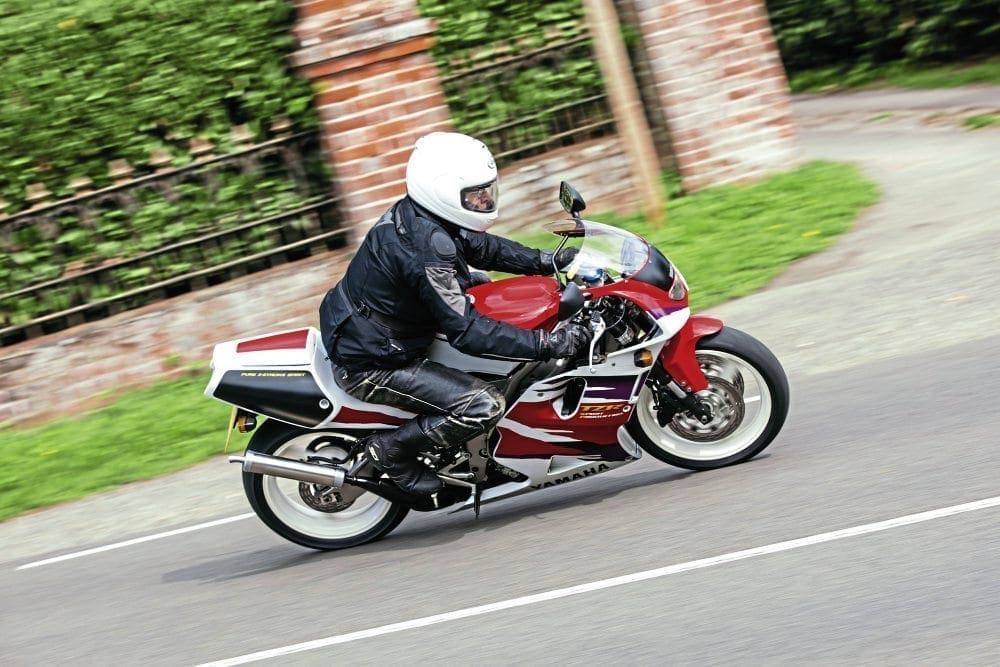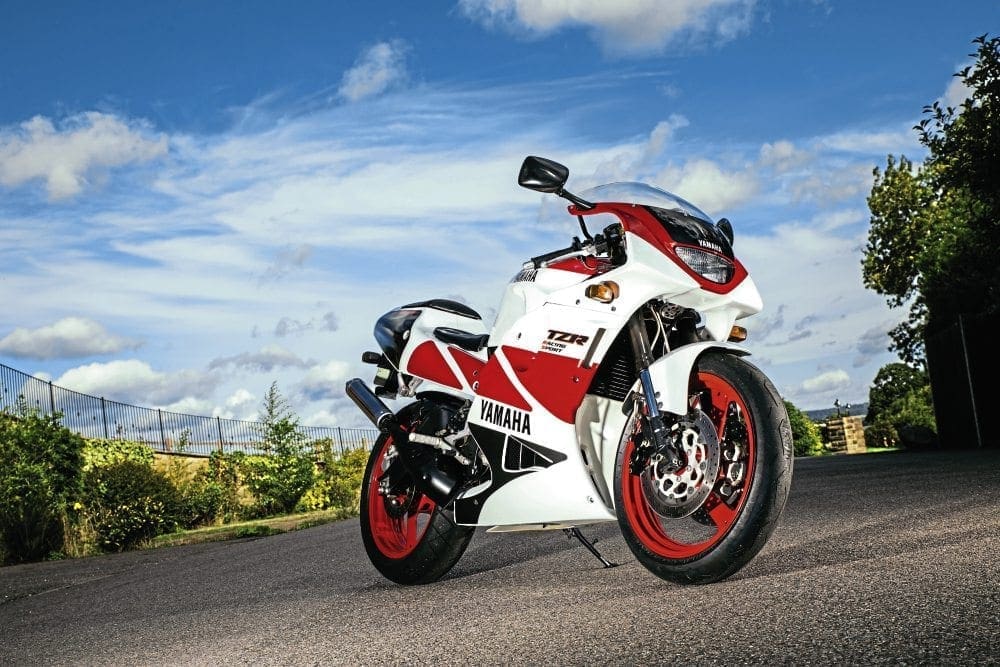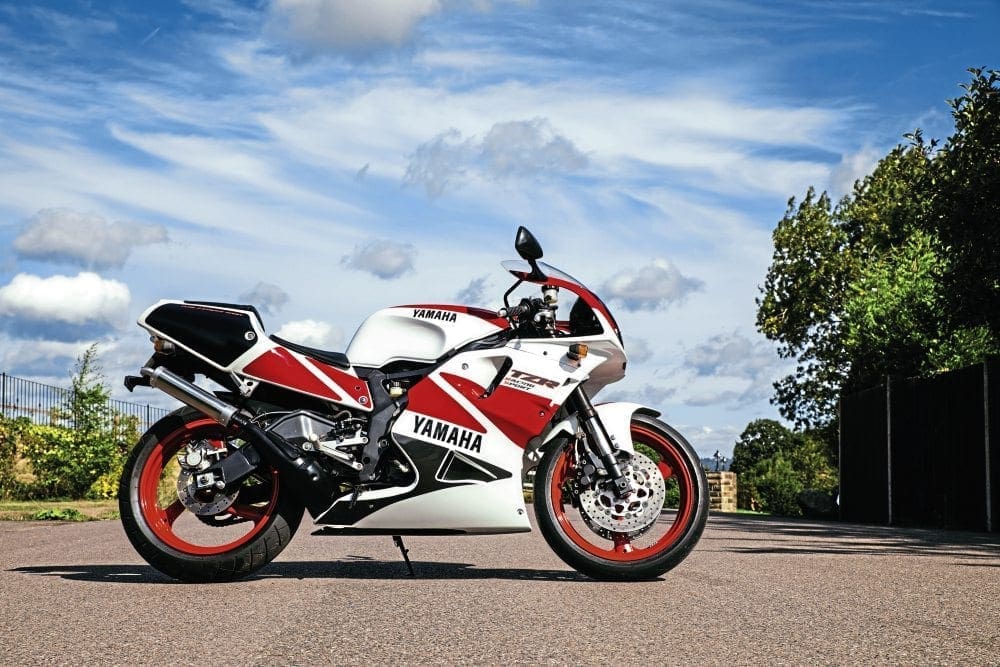If there’s anything better than a big powerful bike, it’s a small powerful bike. John Nutting gets out of his comfort zone and onto a pair of Yamaha TZR250 two-stroke V-twins.

Some say that the 250cc two-stroke twins of the late 1980s and 1990s represent the pinnacle of racing machine technology.
Fans of these machines rue the day when organisers cut the class from international competition, saying that their combination of light weight, relative simplicity and undiluted power made them the ultimate tool for
the track. Being two-strokes, they harked from a less environmentally-conscious
era, so unlike modern machines they were not compromised by having to be
developed from road bikes. These 250cc racers were the real deal, with the factory-prepared
versions offering peak power around 100bhp yet weighing not a lot more than
100kg. They were hard core, and not for the faint-hearted.
The Japanese factories offered
batches of less-potent 250cc racers for sale until the MotoGP era, and even produced
detuned road-going versions. Notably, Suzuki sold its spectacular RGV250 V-twin
in Europe from the late 1980s but with increasingly tough emissions laws the
other factories didn’t think it worth the trouble.

But they did sell their 250cc rockets on the home market in Japan and typically jazzed them up every year in updated versions to keep the performance junkies happy. Yamaha was notable in continuing its TZR250 bloodline with the Deltabox Powervalve parallel-twin 2MA models through the 1980s being followed by the reverse-cylinder 3MA in 1989 and then the 3XV V-twin in 1991, which was offered until 1998.
The 3XV version of the TZR250 was
a distant derivative of the works Yamaha racer that made its debut at the
Silverstone British GP in 1986, the year after Freddie Spencer won the 250cc
and 500cc title double, the smaller bike setting the V-twin theme. Raced by
Venezuelan Carlos Lavado, Yamaha’s YZR250 was however different from the Honda
in that it was in effect the 500cc V4 cut vertically with the cylinders at 60
degrees and geared separately to the clutch basket. Despite Lavado’s
crash-and-burn style, he won the title that year.

It wasn’t until 1991 that Yamaha offered a production racer using the V-twin layout, but by then it had been refined to use a single crankshaft with the big-ends in line and the liquid-cooled cylinders at 90º, with the left one almost vertical and the right slightly below horizontal, enabling the machine to be much more compact. In the UK, the first of these bikes, called the TZ250B, was raced by veteran Manx GP competitor Mick Robinson.
He recalls that he’d been lapping the 37.73-mile Mountain Circuit at around 103mph, but on the B he reached almost 111mph, and gained three podiums in 1991 and 1992. Originally bought for Mick by John Snow of Abinger Garage Doors, it’s now back at Mick’s home. He has photographed a number of racing bikes, including his TZ250B. The images show its low and purposeful appearance.
That same year, Yamaha launched its road-going version of the 250cc V-twin as the latest incarnation of the TZR250 for sale to eager riders in Japan. It essentially looked like the race bike with lights, and although restricted to 45bhp to satisfy domestic market regulations, it came in a version that was easily hopped up with a kit for racing.
None were officially imported to the UK, primarily because of the exhaust emissions, but many have escaped here, which is why I’m contemplating a ride on two examples owned by Owen, who lives in Kent and prefers not to be identified. They’re minters from his collection – one a 1991 RS (Racing Sport) model, the other a 1994 SP (Sport Production), and compared to what I’m accustomed to riding, they look like tiny and delicate jewels that could shatter in a moment.
When you’ve ridden a variety of bikes over a number of years, you often grow to appreciate easy-going power and stable handling. Sharp response is always good, as is nimble steering and a lack of weight, but I wasn’t quite prepared for what Owen’s two-stroke twins were capable of serving up.
First up is the TZR250 SP, the higher-spec model that with a Yamaha RC Sugo kit can be used for racing (see boxout). Even sitting on the bike is a surprise, because it’s so low and slim, and I have to confess that initially it was a struggle to find the foot pegs. Other’s tell me that they couldn’t manage more than a couple of miles on the bike, it felt so cramped – and they were ex-racers.

But I persevered, and found the suspension eerily compliant, even soft in feel as I bounced on it. Switching on the ignition on the top fork yoke, the first sound is of the powervalves turning to clear any carbon. The electrics on the TZR SP are sophisticated and in addition to controlling the exhaust valves, which vary the timing to widen what would otherwise be an impossibly peaky delivery, the timing of the capacitor-discharge ignition is also controlled with a complex advance curve.
There’s also a sensor in the front
carburettor’s opening mechanism to feed back the load to the CDI. The mixture
‘enrichener’ for starting is below the left side of the fuel tank, and needs to
be lifted before you locate the stubby little kick lever on the right. A stab
at the lever and the engine fires up with a crackle from the expansion
chambers. This isn’t a bike for early-morning starts when the neighbours are
still in bed.
Snap the twistgrip in neutral and you’ll hear the jangling of the dry clutch. Remember this is hard-core Japanese kit, and is really necessary if you’re inclined to slip it to get the revs up. I squeeze into the cockpit, stretch my knees, snick onto bottom and ease out to follow Owen onto some typically nadgery Kent roads.
It feels like there’s nothing to the bike and with a claimed dry weight of 128kg, or 282lb in old money, there isn’t much. I try to recall what the RGV250 Suzuki was like three decades ago and the planted steering and stability come to mind, but also the zip in the power delivery.
Want to read the full feature? Then you can get hold of the December 2018 issue of Classic Motorcycle Mechanics, here!



